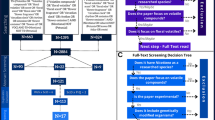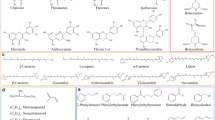Abstract
This study examined how water, sucrose, and frequency of nectar availability affects the longevity of the parasitoid Cotesia glomerata (L.) (Hymenoptera: Braconidae). Under standard laboratory conditions, water did not extend longevity in the absence of sugar in three out of four comparisons, nor did it extend longevity with access to nectar. Cotesia glomerata lived 2–3 days when given water or nothing, 8–15 days when given buckwheat (Fagopyrum esculentum Moench) nectar daily with or without water, and 23–26 days when given a 50% sucrose solution. The lifespan of C. glomerata fed flowers every other day was one-third shorter than that of C. glomerata fed flowers every day, but this difference was not statistically significantly. Only minimal benefits occurred when flowers were given every 3 days.


Similar content being viewed by others
References
Al-Doghairi MA, Cranshaw WS (2004) The effect of interplanting of necteriferous plants on the population density and parasitism of cabbage pests. Southwest Entomol 29:61–68
Azzouz H, Giordanengo P, Wäckers FL, Kaiser L (2004) Effects of feeding frequency and sugar concentration on behavior and longevity of the adult aphid parasitoid: Aphidius ervi (Haliday) (Hymenoptera: Braconidae). Biol Control 31:445–452
Dyer LE, Landis DA (1996) Effects of habitat, temperature, and sugar availability on longevity of Eriborus terebrans (Hymenoptera: Ichneumonidae). Environ Entomol 25:1192–1201
Fadamiro HY, Chen L, Onagbola EO, Graham LF (2005) Lifespan and patterns of accumulation and mobilization of nutrients in the sugar–fed phorid fly, Pseudacteon tricuspis. Physiol Entomol 30:212–224
Fadamiro HY, Heimpel GE (2001) Effects of partial sugar deprivation on lifespan and carbohydrate mobilization in the parasitoid Macrocentrus grandii (Hymenoptera: Braconidae). Annals Entomol Soc America 94:909–916
Hausmann C, Wäckers FL, Dorn S (2005) Sugar convertivility in the parasitoid Cotesia glomerata (Hymenoptera: Braconidae). Arch Insect Biochem Physiol 60:223–229
Idris AB, Grafius E (1995) Wildflowers as nectar sources for Diadegma insulare (Hymenoptera: Ichneumonidae), a parasitoid of diamondback moth (Lepidoptera: Yponomeutidae). Environ Entomol 24:1726–1735
Krugner R, Daane KM, AB Lawson, Yokota GY (2005) Biology of Macrocentrus iridescens (Hymenoptera: Braconidae): a parasitoid of the Obliquebanded leafroller (Lepidoptera: Torticidae). Environ Entomol 34:336–343
Leatemia JA, Laing JE, Corrigan JE (1995) Effects of adult nutrition on longevity, fecundity, and offspring sex ratio of Trichogramma minutum Riley (Hymenoptera: Trichogrammatidae). Can Ent 127:245–254
Lee JC Heimpel GE (2003) Nectar availability and parasitoid sugar feeding. In: R. VanDriesche (ed) Proceedings of the 1st International Symposium on Biological Control of Arthropods, pp. 220–225, 14–18 Jan. 2002, Honolulu, HI, USDA Forest Service, Morgantown, WV
Lee JC, Heimpel GE (2005) Impact of flowering buckwheat on lepidopteran cabbage pests and their parasitoids at two spatial scales. Biol Control 34:290–301
Muniappan R, Bamba J, Cruz J, Reddy GVP (2004) Biology, rearing and field release on Guam of Euplecturs maternus, a parasitoid of the fruit–piercing moth, Eudocima fullonia. BioControl 49:537–551
National Honey Board (2006) Carbohydrates and the sweetness of honey. www.nhb.org. 4 pp
Pinto ML, Salerno G, Wajnberg E (2005) Biology and behaviour of Cirrospilus diallus and Cirrospilus pictus, parasitoids of Phyllocnistis citrella. BioControl 50:921–935
Rice WR (1989) Analyzing tables of statistical tests. Evol 43:223–225
SAS Institute (2001) SAS System, Version 8.02. SAS Institute Inc., Cary, North Carolina
Şengonca Ç, Yugun N, Ulusoy MR, Kersting U (1994) Laboratory studies on biology and ecology of Eretmocerus debachi Rose and Rosen (Hym., Aphelinidae) the parasitoid of Parabemisia myricae (Kuwana) (Hom., Aleyrodidae). J Appl Entomol 118:407–412
Siekmann G, Tenhumberg B, Keller MA (2001) Feeding and survival in parasitic wasps: sugar concentration and timing matter. Oikos 95:425–430
Steppuhn A, Wäckers FL (2004) HPLC sugar analysis reveals the nutritional state and the feeding history of parasitoids. Functional Ecol 18:812–819
Wäckers FL (1999) Gustatory response by the hymenopteran parasitoid Cotesia glomerata to a range of nectar and honeydew sugars. J Chem Ecol 25:2863–2877
Wäckers FL (2000) Do oligosaccharides reduce the suitability of honeydew for predators and parasitoids? A further facet to the function of insect–synthesized honeydew sugars. Oikos 90:197–201
Wäckers FL (2001) A comparison of nectar– and honeydew sugars with respect to their utilization by the hymenopteran parasitoid Cotesia glomerata. J Insect Physiol 47:1077–1084
Wäckers FL, Lee JC, Heimpel GE, Winkler K, Wagenaar R (2006) Hymenopteran parasitoids synthesize “honeydew–specific” oliogosaccharides. Functional Ecol 20:790–798
Wanner H, Hainan G, Dorn S (2006a) Nutritional value of floral nectar sources for flight in the parasitoid wasp Cotesia glomerata. Physiol Entomol 31:127–133
Wanner H, Hainan G, Günther G, Hein S, Dorn S (2006b) Tracing spatial distribution of parasitism in fields with flowering plant strips using stable isotope marking. Biol Control 39:240–247
Winkler K (2005) Assessing the risks and benefits of flowering field edges. Ph.D. Thesis, Wageningen University, Netherlands p 118
Winkler K, Wäckers FL, Bukovinszkine–Kiss G, van Lenteren JC (2006) Sugar resources are vital for Diadegma semiclausum fecundity under field conditions. Basic Appl Ecol 7:133–140
Acknowledgments
This research was funded in part by USDA NRI Grant no. 9802906, a USDA North Central Regional IPM grant to G.E.H., New Graduate Student Fellowship to J.C.L., and the University of Minnesota Agricultural Experiment Station.
Author information
Authors and Affiliations
Corresponding author
Rights and permissions
About this article
Cite this article
Lee, J.C., Heimpel, G.E. Effect of floral nectar, water, and feeding frequency on Cotesia glomerata longevity. BioControl 53, 289–294 (2008). https://doi.org/10.1007/s10526-007-9070-8
Received:
Accepted:
Published:
Issue Date:
DOI: https://doi.org/10.1007/s10526-007-9070-8




